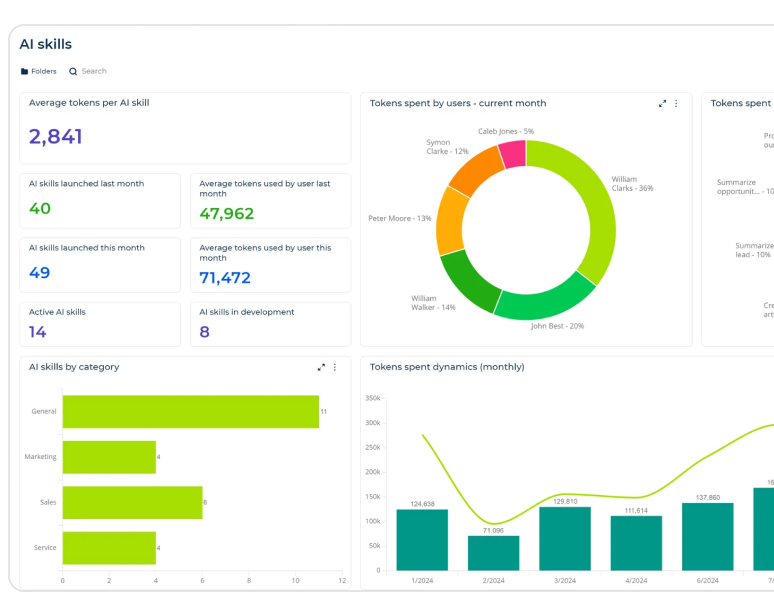-
No-Code
Platform
-
Studio
No-code agentic platform delivering the fastest time-to-value and the highest ROI
-
Studio
-
AI-Native CRM
CRM
-
AI-Native CRM
New era CRM to manage customer & operational workflows
CRM Products -
AI-Native CRM
- Industries
- Customers
- Partners
- About
Agentic AI - The Key to Unleashing Next-Level Business Productivity
Updated on
August 05, 2025
13 min read
Reduce Manual Effort and Streamline Daily Tasks

Agentic AI is emerging as a new frontier in the evolution of artificial intelligence. According to Gartner, agentic AI is one of the top 10 strategic technology trends for 2025 thanks to its ability to tackle complex tasks, adapt to changing environments, and augment human work. And the market is following suit: according to Grand View Research, the global AI agents market is set to grow from $5.4 billion in 2024 to over $50 billion by 2030, highlighting the rising demand for AI systems that can operate with greater independence.
This article explores what agentic AI is and its potential to transform the way businesses operate.
What is Agentic AI?
Agentic AI is an advanced form of artificial intelligence designed to make autonomous decisions and execute tasks with minimal human intervention. AI agents are capable of planning, automating tasks, evaluating performance, and optimizing workflows.
AI agents work autonomously by analyzing vast amounts of data to understand user or customer context and make decisions to execute tailored workflows. Additionally, AI agents learn from new scenarios, handle exceptions, tackle complex challenges, and adapt to changing conditions to optimize workflows and improve processes.
Agentic AI is characterized by these key aspects:

- Autonomy - AI agents can execute and improve tasks independently without constant human intervention.
- Reasoning - AI agents can reason through complex scenarios and plan next steps.
- Complex decision-making - autonomous agents can make crucial decisions based on multiple factors and long-term goals.
- High adaptability - AI agents continuously learn and adapt to new data and changing conditions, which makes them highly useful in dynamic environments.
- Comprehension - AI agents can navigate and execute multi-step processes by combining various models, data sources, and external systems.
Agentic AI can think, plan, and act independently but can still benefit from users' guidance to align with business goals, ethical standards, and compliance regulations.
The State of AI Agents & No-Code
Learn how 560+ leaders across the world use AI and no-code to drive innovation today
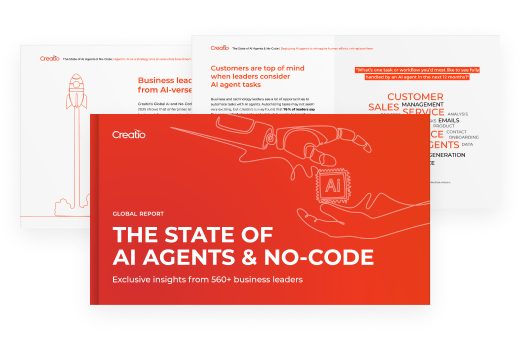
How Exactly Does Agentic AI Work?
Agentic AI operates through a combination of machine learning algorithms, natural language processing (NLP), and large language models (LLMs).
AI agents go through 5 steps to execute tasks:

- Perception - gather and process data from all available data sources.
- Reasoning - understand tasks and generate solutions.
- Action - integrate external tools and software to perform a task based on the formulated plan.
- Feedback and adjustment - monitor task execution, analyze outcomes, and refine strategies.
- Learning - continuously learn from each interaction to improve accuracy and efficiency in real-time.
This is a more detailed explanation of each step of the process:
Step | What happens | How it happens |
| Perception and data gathering | The AI agent gathers and analyzes data from available databases and other digital interfaces using machine learning technology. | The agent identifies relevant features and recognizes objects or key entities from the business environment (customer data, performance metrics, product specifications). context and current state of the environment, enabling AI agents to act accordingly. |
| Understanding tasks | The agent interprets instructions in natural language using Natural Language Processing (NLP) technology. | Large language models (LLMs) convert human language into structured, actionable representations using prompt engineering and template matching. The goal of this step is to break down complex tasks into more digestible ones, which agentic AI can work with. |
| Reasoning | The agent uses an LLM to understand tasks, generate potential solutions, and coordinate specialized models for specific tasks, such as content creation and recommendation systems. | The AI agent uses techniques like retrieval-augmented generation (RAG) to access the right information from diverse data sources to ensure accurate and relevant outputs. The goal of this task is to make informed decisions based on available data. |
| Task planning | The agent breaks down tasks and creates multiple action plans. | It generates task sequences and maps out the necessary steps while respecting dependencies (like prioritizing tasks and deadlines). The goal of this step is to ensure that tasks are performed in a logical order and that there are no errors. |
| Task execution | The agent starts executing tasks.
| The agent integrates with existing enterprise systems and external tools (such as CRM software, an e-commerce platform, or analytics tools) to complete actions based on its plans. The goal of this step is to accomplish the task(s) as effectively as possible. |
| Task monitoring | While the agent executes tasks, it monitors for success or failure signals. | Pre-programmed rules help the agent assess the outcomes and adjust if something goes wrong. The main goal of this step is to adapt the approach and avoid unnecessary errors. |
| Fallback options | If the agent faces obstacles or unexpected errors, it refers to fallback options. | The agent uses success/failure metrics to choose alternative paths, ensuring it can still complete tasks even when errors or changes occur. The main goal of this step is to maintain flexibility and ensure there’s progress despite challenges. |
Continuous learning | The agent logs each action, decision point, and outcome.
| Data generated during interactions with users and other systems is stored in the system and used by AI agents to learn and improve. The main goal of this step is to continuously learn from past experiences, refine processes, and improve decision-making over time. |
Agentic AI vs. Generative AI
Generative AI was the first type of AI to break into the mainstream, with tools like ChatGPT, DALL·E, and other AI models leading the way. These artificial intelligence systems proved that AI can be accessible to ordinary people, who could use it to generate human-like text, create images, and even streamline software development.
Now, the focus is shifting toward agentic AI, a new wave of AI that doesn't just respond to prompts but actively takes initiative. Instead of completing one-off tasks, agentic AI systems can automate complex workflows, make decisions, plan next steps, and take actions to achieve specific goals.
Here’s a side-by-side comparison to highlight the key differences:
Aspect | Generative AI | Agentic AI |
|---|---|---|
| Purpose | Generate content (text, code, images, videos, etc.) | Autonomously pursue and achieve goals by planning, making decisions, and executing complex workflows |
| Autonomy level | Low – requires constant human input | High – can operate independently, make decisions, execute tasks, and handle complex scenarios |
| Adaptability | Requires human feedback to adapt output | Learns from past outcomes and autonomously adapts to improve performance |
| Example use case | Drafting an email or generating ad creatives | Managing a sales pipeline or answering customer service inquiries |
| Enterprise impact | Accelerates content production | Automates business processes and augments human roles |
Benefits of Working with Agentic AI
Agentic AI is a powerful tool that helps businesses streamline operations, enhance decision-making, and improve productivity.
In this section, we explore the key advantages of integrating agentic AI into business operations:

Increased efficiency and productivity
Agentic AI enhances efficiency and productivity by automating complex processes that traditionally required human attention. Unlike conventional automation, intelligent agents don’t just follow predefined rules, they can autonomously make decisions to execute tasks and optimize workflows, freeing up employees to focus on creative and strategic work.
Proactive problem-solving
Agentic AI doesn’t just automate routine tasks and follow users' instructions. Unlike traditional systems that require humans to react to problems after they occur, AI-powered agents continuously monitor operations, analyze patterns, and take proactive actions to mitigate issues before they occur.
For example, agentic AI can make a decision to adjust transportation routing by analyzing real-time traffic and weather data, without waiting for a human employee to notice that there might be an issue.
Enhanced customer experiences
Agentic AI transforms customer interactions by providing more personalized and responsive experiences. Agentic AI analyzes user messages, preferences, and situational context to provide tailored and relevant help without engaging customer support specialists. AI agents can engage with customers 24/7 in natural language, providing instant support, answering questions, and even performing tasks on their behalf, like filing a complaint.
Implementing agentic AI systems reduces wait times, improves resolution rates, and ensures a smoother, more engaging customer experience - ultimately driving higher customer satisfaction and loyalty.
Flexibility and adaptability
One of the biggest advantages of agentic AI is its ability to adapt to changing conditions without human involvement. Agentic AI systems learn from new data in real time and can independently adjust to shifting business needs, changing conditions, and new challenges.
Data-driven decision-making
Agentic AI empowers businesses with smarter, faster decision-making by analyzing vast amounts of data in real time. Instead of relying on static reports or manual analysis, AI agents operate by continuously processing and interpreting data, uncovering patterns, trends, and insights that might otherwise go unnoticed. With this capability, businesses can make more informed, data-driven decisions.
Agentic AI Use Cases
Users can partner with specialized agents, called vertical AI agents, tailored to their role and work together to fulfill specific tasks. Here are some use cases across different business functions and operations, including marketing, finance, and sales:
Marketing
AI agents support marketing professionals by autonomously managing and optimizing marketing campaigns. By analyzing audience engagement and performance metrics, marketing AI agents can adjust bidding and refine targeting strategies in real time to increase campaign ROI.
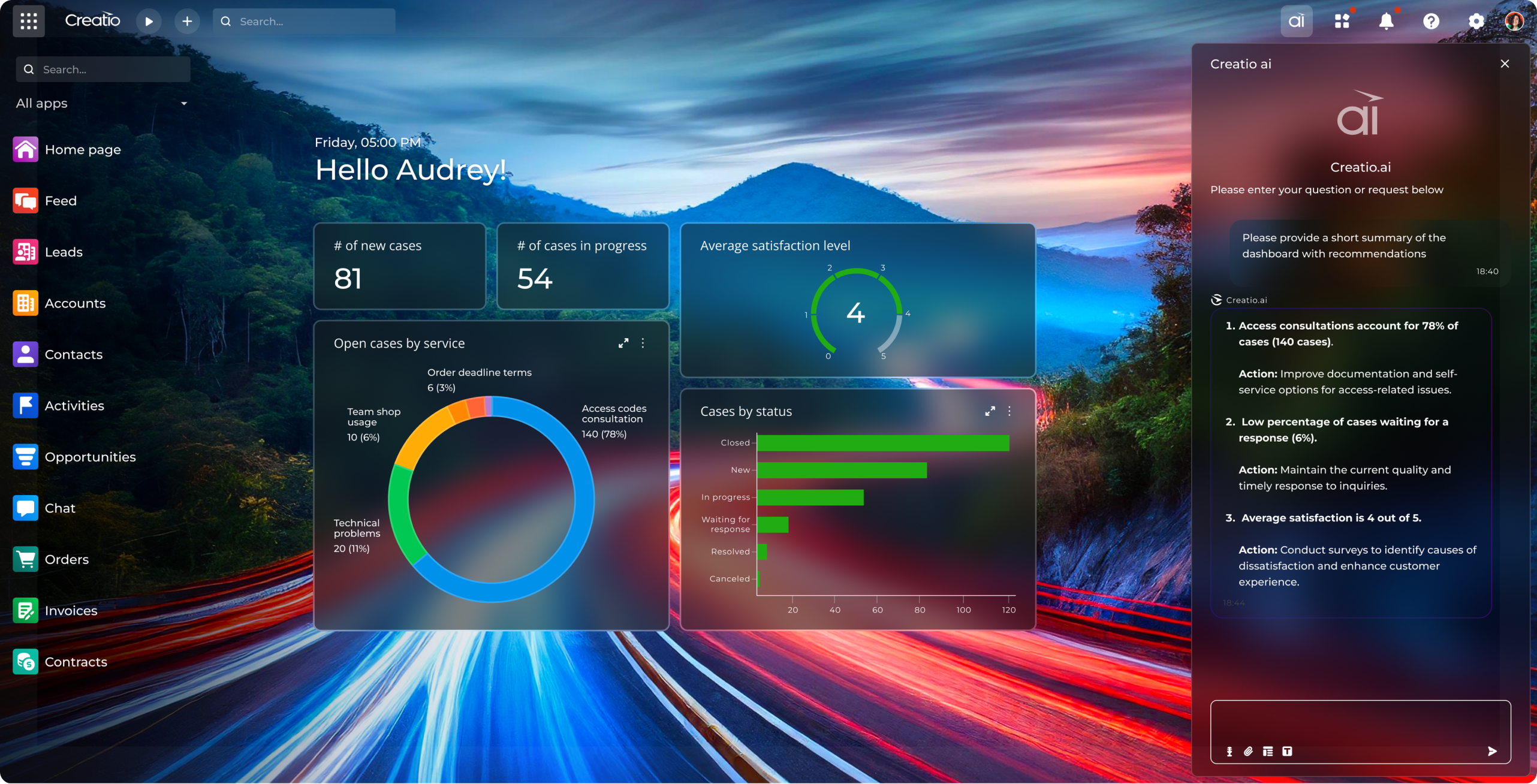
Example of Creatio.ai for marketing
Agentic AI systems for marketing can automate:
- Audience segmentation - automatically group customers into similar segments and update segmentation based on new data
- Campaign execution - automatically execute marketing campaigns by analyzing customer behavior, such as abandoning shopping carts, downloading resources, browsing certain product categories, viewing pricing page, etc.
- Campaign optimization - analyzes campaign performance and adjusts ad bidding, ad placement, channels, ad variation, etc.
For example, an e-commerce company can implement agentic AI to manage a multi-channel advertising campaign to promote a new line of products. An AI marketing agent monitors ad performance across Facebook, Google, and Instagram in real time and notices that a particular segment of users prefers video ads rather than static images. Instead of waiting for a marketing specialist to make changes to the ad format, the AI agent independently shifts it to video for those users, further improving their engagement.
Sales
Agentic AI acts as an intelligent assistant, helping sales professionals focus on establishing relationships with clients by automating a significant portion of sales agents’ everyday workload. For example, AI sales agents can autonomously update prospect data based on calls and chats, schedule meetings with the most valuable prospects, and automatically send follow-up messages.

Example of Creatio.ai for sales
Additionally, agentic AI for sales can automate:
- Lead and opportunity scoring - automatically assess leads and opportunities to determine how likely they are to become customers
- Lead distribution - assign the best sales representative based on skills, experience, location, etc.
- Pipeline management - monitors the sales pipeline and takes actions to keep deals moving, such as sending automated emails, scheduling calls, etc.
- Territory optimization - assigns sales representatives working in the field based on their availability, experience, and location.
Agentic AI can autonomously execute sales workflows based on a potential client's behavior. For example, when someone fills out the contact form, an AI agent can analyze their data, look for additional information in various databases to create a complete profile, automatically send a welcoming message, schedule a meeting with the rights sales agent, and support sales professionals during meetings by providing valuable insights that will help them close the deal faster.
Customer Service
Traditional chatbots help improve customer service by answering common questions and providing timely support 24/7, however, agentic AI transforms customer service by autonomously making decisions and executing tasks on behalf of customers.
Businesses that leverage AI agents for customer service can resolve issues faster, reduce operational costs, and deliver proactive support, without increasing human workload. Gartner predicts that by 2029, agentic AI will autonomously resolve 80% of common customer support issues, which will help businesses reduce operational costs by up to 30%.
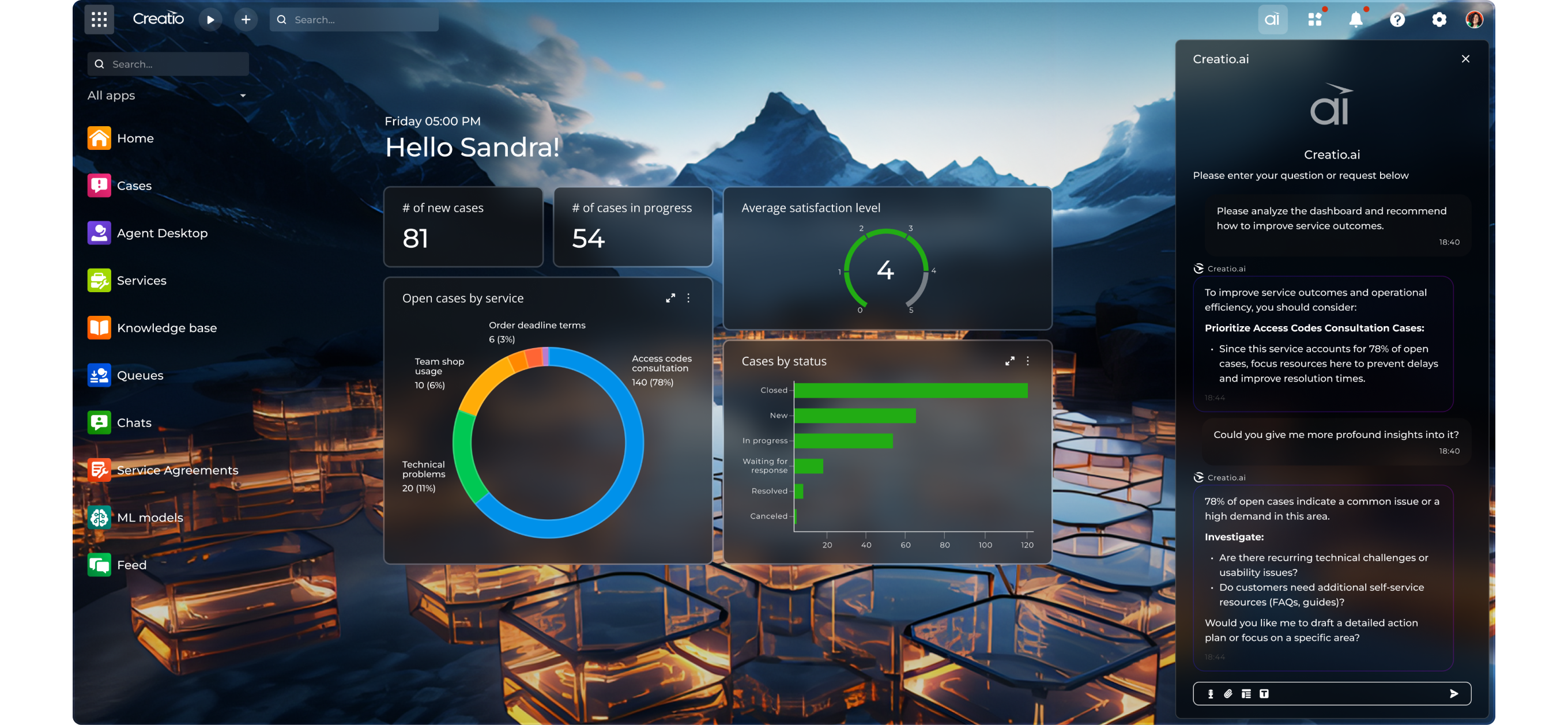
Example of Creatio.ai for customer service
The biggest advantage of agentic AI for customer service is that AI agents can analyze customer requests, make real-time decisions, and take actions on their behalf, such as canceling subscriptions, rescheduling appointments, processing refunds, etc.
For example, an AI agent can analyze a customer’s request to return a product. Instead of sending them generic instructions, an AI agent can autonomously verify order details, assess their eligibility for a refund, fill out the return form with customer information from the company’s database, prepare a return label, and send all the information to the customer, all within seconds and without engaging customer service agents.
Agentic AI for customer service can also automate:
- Case routing and prioritization – analyze the sentiment, urgency, and complexity of the case to prioritize and route cases to the best-suited agent.
- Process service request – analyze the service request, logs it into the system, assigns service agent based on location and availability, and updates the customer profile based on service documentation.
- Case resolution recommendations - search the knowledge base, previously resolved cases, and other reliable sources to provide insights on how to resolve a specific case best.
- Knowledge base updates - analyze resolved cases and suggest updates to the knowledge base.
Finance
Agentic AI supports finance departments by autonomously handling transactions, monitoring risks, and processing invoices. Unlike predictive AI, which only provides actionable insights, agentic AI can take action to improve efficiency, security, and accuracy.
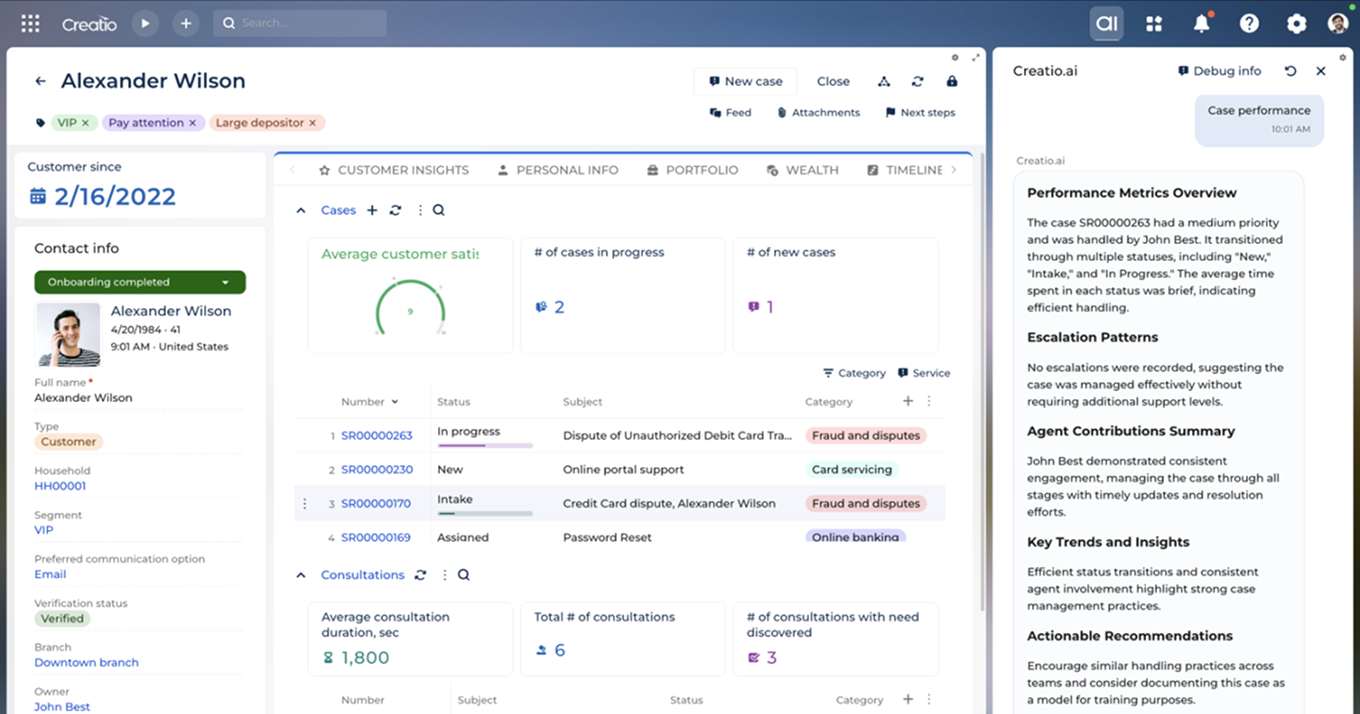
Example of Creatio Finserv AI agent
AI agents for finance can autonomously:
- Monitor transactions and prevent fraud - continuously scan financial transactions, detect anomalies, and take immediate action to prevent fraud before it impacts the company and its customers.
- Process invoices – process invoices and match them with purchase orders, check invoices for errors, and streamline approvals.
- Process loans - financial institutions can use agentic AI to evaluate loan applications, check creditworthiness, and automatically approve or adjust terms based on risk assessment.
- Manage portfolios - wealth management and investment firms can implement an AI agent to monitor market conditions and adjust portfolios to align with clients' goals and risk tolerance.
Agentic AI systems can analyze transaction patterns to flag suspicious activity, helping businesses fight with cyber-security threats and money-laundering activities. For example, if a bank’s AI agent detects an unusual transaction from a customer’s account in a foreign country, it can freeze the transaction, alert the customer via a mobile app, and request verification, preventing potential fraud.
Explore more examples of AI agents across different industries and functions.
Creatio's Agentic AI for Enterprises - Driving Business Innovation and Digital Transformation
Agentic AI transforms how enterprises operate, compete, and deliver value by enabling intelligent, autonomous, and self-optimizing process automation. A great example of agentic AI for enterprise needs is Creatio - an agentic CRM and workflow platform with no-code that combines key AI aspects, including generative, predictive, and agentic AI to automate end-to-end business processes, enhance customer engagement, and optimize business operations.
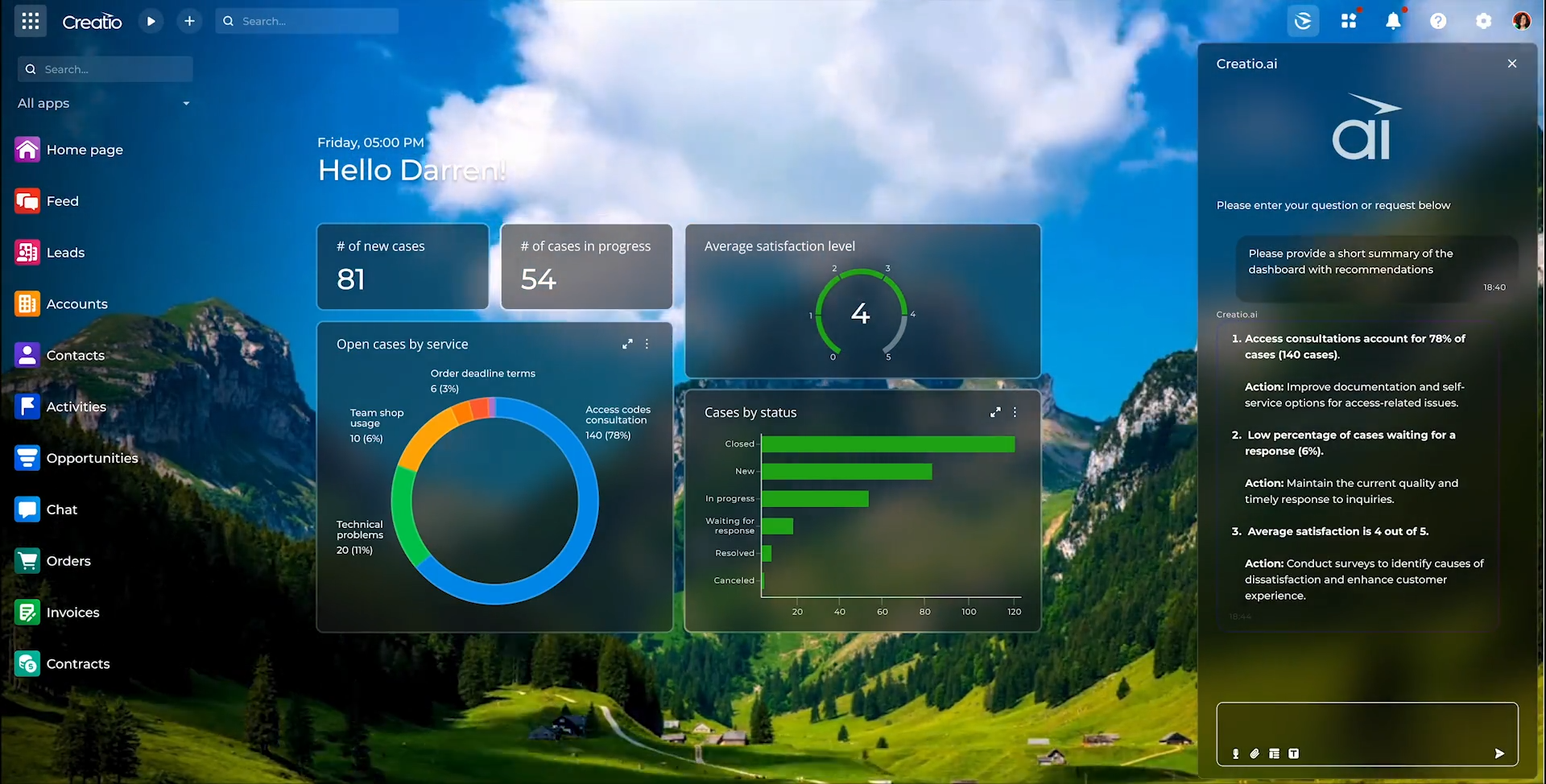
Creatio.ai
Creatio.ai is a virtual AI assistant that executes complex workflows and performs tasks on behalf of users with minimal human oversight. Thanks to native AI capabilities integrated directly into the system, users can benefit from all AI capabilities by using natural language and a simple interface. With built-in awareness of all objects, relationships, data, and processes, Creatio.ai can act upon all the information available on the platform.
AI agents are an integral component of the Creatio platform, delivering insights, prioritizing work, and assisting in employees' daily tasks. They monitor the business environment, automate actions, and recommend next steps to enhance employee productivity.
Creatio provides a set of AI agents designed for specific job functions:
- Sales - businesses can accelerate deal cycles by using Sales AI agents, such as Account Research Agent, a Meeting Agent, and a Quote Generation Agent to streamline prep work, tailor communication, and proactively recommend next steps based on intelligent insights and real-time context.
- Marketing - Marketing professionals can benefit from tailored AI agents, such as Marketing Content Agents, Email Generation Agents, and Lead Conversion Agents, to scale content creation and automate campaign execution.
- Service - customer support representatives can use AI agents to increase the speed and accuracy of case resolution. By leveraging insights provided by a Customer Support Agent and a Knowledge Base Agent, they can streamline communication across channels and provide more personalized customer interactions.
- Finance - financial institutions can leverage purpose-built AI agents to support a range of tasks, from customer onboarding and credit scoring to underwriting, fraud prevention, KYC/AML compliance, and more.
Employees can tailor agents to fit their preferences and unique tasks or create new AI agents to better answer their requirements. By taking advantage of Creatio's composable no-code architecture, users can create new AI agents without writing any code and easily integrate them into existing workflows.
Creatio.ai is built with security, transparency, and accountability at its core. It delivers robust, enterprise-ready safeguards for data privacy and compliance, ensuring organizations can confidently adopt AI without compromising trust. With a strong emphasis on human oversight, Creatio.ai integrates a human-in-the-loop approach to maintain control over AI-driven decisions—reinforcing ethical use and operational transparency.
Future of Agentic AI
Artificial intelligence rapidly evolves from automating repetitive tasks to intelligent, autonomous systems. As organizations adopt modern agentic AI systems, the workplace will evolve, with AI agents taking on more complex responsibilities, collaborating with employees, and making decisions fully independently.
In this section, we explore how agentic AI is expected to develop in the coming years and the transformative impact it will have:
Advancing adaptation of agentic AI technology
As we look ahead, the integration of agentic AI will transform business operations, leading to more autonomous workflows and enhanced decision-making capabilities. Gartner forecasts that by 2028, 33% of enterprise software applications will incorporate agentic AI, a significant increase from less than 1% in 2024. According to Forrester’s research, within the next three years, agentic AI will gain trust, and enterprises will use autonomous agents to control and manage a significant portion of their processes.
Gartner predicts that by 2028, as much as 15% of daily work decisions will be made autonomously, and organizations that proactively embrace agentic AI will be the ones reaping the fruits.
Evolution of agentic AI systems
According to Forrester, over the next few years, agentic AI will evolve from role-specific agents to multi-agent systems capable of coordinating multiple use cases at once. As technology evolves, multiple agents will be able to communicate and collaborate to execute multi-layered processes and resolve increasingly complex problems.
Forbes predicts that in the near future, AI agents will evolve from simple tools into partners. Employees will develop more collaborative relationships with agentic AI that will become a crucial part of everyday operations, supporting strategic initiatives and enhancing business innovation.
At Creatio, we believe agentic AI enhances human potential, which is why our platform enables seamless collaboration between human and digital talent. AI agents seamlessly integrate into daily workflows, adapting to individual tasks and preferences to enhance users’ productivity. By taking over time-consuming and repetitive tasks, they allow employees to focus on more creative and strategic work. Businesses that embrace this combination of digital and human talent can reach new heights in productivity, efficiency, and agility, reshaping the future of business operations.





















































